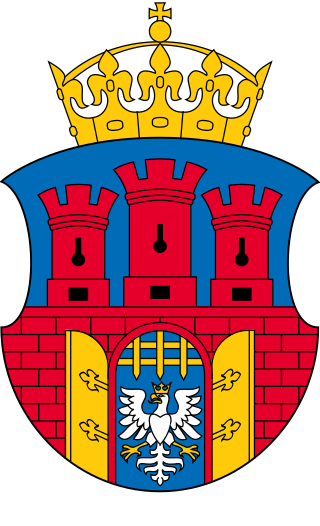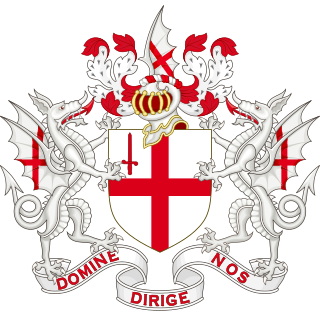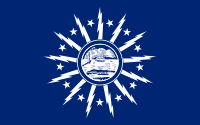
The national flag of Switzerland displays a white cross in the centre of a square red field. The white cross is known as the Swiss cross or the federal cross. Its arms are equilateral, and their ratio of length to width is 7:6. The size of the cross in relation to the field was set in 2017 as 5:8. Alongside the flag of Vatican City, the Swiss flag is one of only two square national flags in the world.

The flag of the United States Territory of Guam was adopted on February 9, 1948. The territorial flag is a dark blue field with a narrow red border on all sides. The red border – a later addition – represents the blood spilled during World War II and earlier Spanish sovereignty. In the center of the flag is the Seal of Guam; almond in shape, it depicts a proa sailing in Hagåtña Bay near Hagåtña, and GUAM in red letters. The shape of the emblem recalls the slingshot stones used by ancient Chamorro people. The landform in the background depicts the Two Lovers Point cliff on the northern edge of Tumon. Charles Alan Pownall, the military Governor of Guam, approved the design in 1948.

The flag of Delaware consists of a buff-colored diamond on a field of colonial blue, with the coat of arms of the state of Delaware inside the diamond. Below the diamond, the date December 7, 1787, declares the day on which Delaware became the first state to ratify the United States Constitution. The colors of the flag reflect the colors of the uniform of General George Washington.

The coat of arms of Birmingham City Council was granted in 1977 and includes various elements related to the area the council governs: the metropolitan borough of Birmingham in the county of the West Midlands, England.

The flag of Great Britain, commonly known as King's Colours, the first Union Flag, the Union Jack, or the British flag, was used at sea from 1606 and more generally from 1707 to 1801. It was the first flag of the Kingdom of Great Britain. It is the precursor to the Union Jack of 1801.

The city of Kraków uses a coat of arms, a seal, official colors, a flag, and a banner as its official symbols. Additionally, a number of semi-official and unofficial symbols of the city are also used.

Canting arms are heraldic bearings that represent the bearer's name in a visual pun or rebus.

Buff is a light brownish yellow, ochreous colour, typical of buff leather. Buff is a mixture of yellow ochre and white: two parts of white lead and one part of yellow ochre produces a good buff, or white lead may be tinted with French ochre alone.

The seal of New York City is the city's official corporate insignia. According to the city's Administrative Code, it is used to identify documents or publications issued under the authority of the city or its departments. It is also engraved into property owned by the city, used to identify officers of the city, and featured on the city's flag.

The coat of arms of Cape Town is the traditional symbol of the municipality of Cape Town. The original arms from the 20th century are no longer in official use, though no new arms have yet been adopted.
The municipal seal of Buffalo is the official seal of the City of Buffalo, United States. The seal contains a historic depiction of Buffalo harbor surrounded by the legend, "Seal of the City of Buffalo."

The coat of arms of the city of Victoria was granted in 1962, and then subsequently registered with the Canadian Heraldic Authority in 2005. While the city employs a logo for common use, the arms are reserved for legal documents and for more historical or traditional purposes and events.

The coat of arms of Albany, New York, is the heraldic symbol representing the city of Albany, the capital of the U.S. state of New York. The coat of arms is rarely seen by itself; it is almost always used in the city seal or on the city flag. The current coat of arms was adopted in 1789, although prior to that it was significantly simpler, ranging from stylized lettering to a caricature of a beaver. Included in the coat of arms are references to Albany's agricultural and fur-trading past. It is supported by a white man and an American Indian and is crested by a sloop. The coat of arms is meant to represent the "symbols of industry and its rewards to man and beast on land and sea".

A number of cross symbols were developed for the purpose of the emerging system of heraldry, which appeared in Western Europe in about 1200. This tradition is partly in the use of the Christian cross an emblem from the 11th century, and increasingly during the age of the Crusades. Many cross variants were developed in the classical tradition of heraldry during the late medieval and early modern periods. Heraldic crosses are inherited in modern iconographic traditions and are used in numerous national flags.

The coat of arms of the City of London Corporation is the official coat of arms granted to the City of London Corporation. The Corporation governs the City of London, one of the 33 administrative areas within Greater London, England.
Greater London does not currently have an official flag to represent the region. However, the current Greater London Authority and predecessor bodies have historically flown and used many flags and symbols.

The flag of Knoxville, Tennessee, was officially adopted by municipal ordinance on October 16, 1896. It is the third oldest official city flag in the United States and the oldest flag of any state or city governmental entity in Tennessee.
The City of Springfield, Massachusetts has two official symbols, and is also often represented by depictions of the Municipal Group as a de facto emblem of its government.

The flag of Austin is the official municipal flag of Austin, Texas. The flag simply consists of a white field with the seal of Austin without the surrounding circle of text. Below the seal of Austin is the text "CITY OF AUSTIN", written in blue and arched upwards.

The flag of Columbus is the official municipal flag of Columbus, Ohio. Its current design is a yellow, white, red vertical triband with the city seal on a blue field. Officially, the flag was adopted in 1929, although it is unknown if the flag was ever flown when it was first adopted.


















